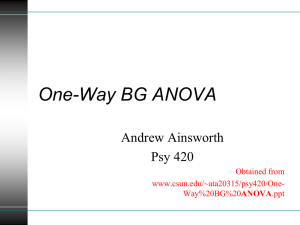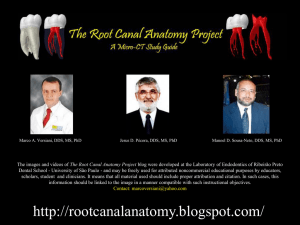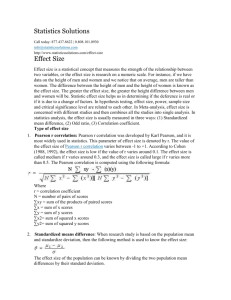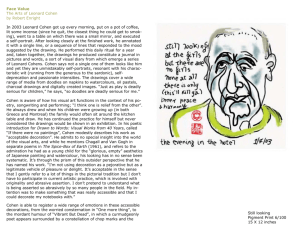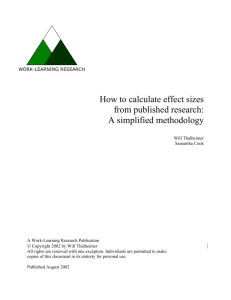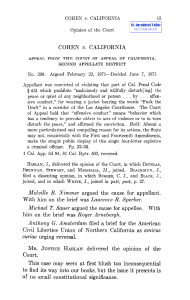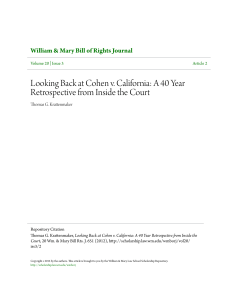Nathan_Cohen_Introduction
advertisement
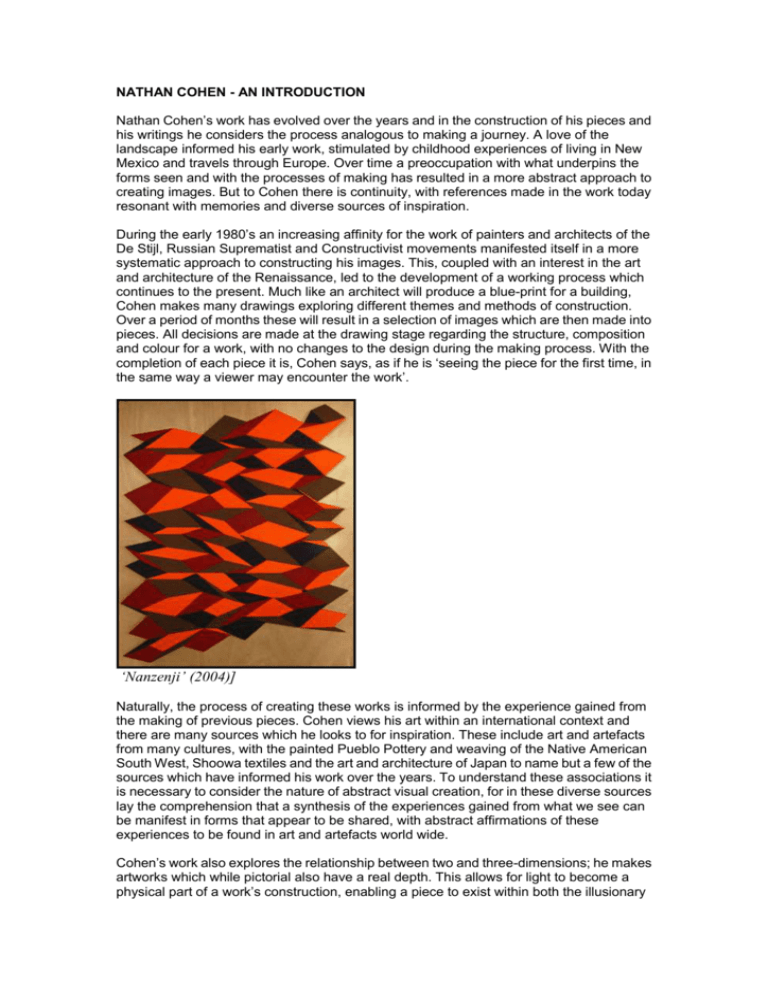
NATHAN COHEN - AN INTRODUCTION Nathan Cohen’s work has evolved over the years and in the construction of his pieces and his writings he considers the process analogous to making a journey. A love of the landscape informed his early work, stimulated by childhood experiences of living in New Mexico and travels through Europe. Over time a preoccupation with what underpins the forms seen and with the processes of making has resulted in a more abstract approach to creating images. But to Cohen there is continuity, with references made in the work today resonant with memories and diverse sources of inspiration. During the early 1980’s an increasing affinity for the work of painters and architects of the De Stijl, Russian Suprematist and Constructivist movements manifested itself in a more systematic approach to constructing his images. This, coupled with an interest in the art and architecture of the Renaissance, led to the development of a working process which continues to the present. Much like an architect will produce a blue-print for a building, Cohen makes many drawings exploring different themes and methods of construction. Over a period of months these will result in a selection of images which are then made into pieces. All decisions are made at the drawing stage regarding the structure, composition and colour for a work, with no changes to the design during the making process. With the completion of each piece it is, Cohen says, as if he is ‘seeing the piece for the first time, in the same way a viewer may encounter the work’. ‘Nanzenji’ (2004)] Naturally, the process of creating these works is informed by the experience gained from the making of previous pieces. Cohen views his art within an international context and there are many sources which he looks to for inspiration. These include art and artefacts from many cultures, with the painted Pueblo Pottery and weaving of the Native American South West, Shoowa textiles and the art and architecture of Japan to name but a few of the sources which have informed his work over the years. To understand these associations it is necessary to consider the nature of abstract visual creation, for in these diverse sources lay the comprehension that a synthesis of the experiences gained from what we see can be manifest in forms that appear to be shared, with abstract affirmations of these experiences to be found in art and artefacts world wide. Cohen’s work also explores the relationship between two and three-dimensions; he makes artworks which while pictorial also have a real depth. This allows for light to become a physical part of a work’s construction, enabling a piece to exist within both the illusionary pictorial space and the real space of the viewer. The linear constructions of the mid-1980’s developed this theme, exploring ideas of how to define an edge or boundary to a work, both in relation to itself and the architecture within which it exists. This developed in forms examining the vertical and the horizontal, the external and the internal, with the non-hierarchical structure of the square predominating. The sense of a journey both around and through a work is revealed through the linear elements composing each piece. ‘Untitled Series C12/No.1 (1986) Initially, the work was made with mahogany and all colour eliminated in a desire to explore the properties of the material and to define as clearly as possible the structure of the form. The grain of the wood gave directional value indicating a pathway through each piece and revealing its method of construction. Subsequent work began to explore how structure could be related to colour, with specific choices made according to different ordering principles in relation to the construction of each piece. ‘Stem’ (1990) A shift to working with aluminium allowed for greater stability in the projection of linear elements, with the work of the late 1980’s and early 1990’s exploring structures which moved away from the orthogonal and articulated the space in more dynamic ways. Each element represents a particular journey between two given points in space, each relating to the structure of the whole. Colour values for the linear elements relate to their location and directional value, with all colours mixed proportionally from three primary colours. A sense of space which is not just a void but an integral part of the construction has informed Cohen’s work from the early constructions. The Japanese term ‘ma’, which may be defined as that ‘space or interval which is necessary to give shape to the whole’(2), Cohen believes is significant for creating a pictorial form which can also exist within the real world of the viewer. ‘Untitled (Harmonic Form)’ (1991)] “One of the big challenges for an artist is how to make an illusion of space appear real, and by extension find a way to make real what is in essence an invention. This invention is the product of a complex mix of the desire to see and intention to make, born of a synthesis of all those experiences gained from living within the world around us. The pictorial offers us a way to explore these experiences and reinvent the world we see, and at its best manifests itself in images and forms which challenge and enhance our comprehension. I believe that it is possible to invent with spatial arrangement which may be clearly defined and yet also open to interpretation, for while the picture plane may be viewed as a window onto an illusion of space, it is also the surface upon which spatial reality may be rebuilt.”(1) One spatial implication raised in the linear aluminium constructions of the 1980’s-mid 90’s was the question of how perception of space could be challenged by the orientation of elements in relation to each other. Certain visual phenomena became of interest with linear elements appearing to curve and by noting how changes in movement and light affected the viewing of a piece. Seeking to explore these ideas further, notions of a curved or woven space became important resulting in the painted panel constructions from the early 1990’s onwards. These works, initially in black, white and grey, and later in colour, play with the relationship between two and three dimensional form. The eye is encouraged to make a journey through the piece, encountering at one moment an area which appears to advance then suddenly recede, with an element often modulating from one spatial orientation to another when seen in proximity to neighbouring elements. Notions of symmetry and asymmetry also evolve with the articulation of form considered in relation to the wider architectural space within which pieces reside. ‘Triaddic Form’ (2004) “If the picture plane itself is something that may be invented with in the creation of an image, it would seem reasonable to assume that it need not be visually conceived of as being flat. Inventing with the visual topology of the surface, while retaining its physical characteristic as a flat panel, has enabled me to create images, which while they may initially appear to adopt certain spatial characteristics shift their reading over time. The structure itself should define its own existence in space, and not be confined to a picture window illusion of space. By liberating the form and allowing it to grow within our perceived ‘real’ physical space, the play of light and shadow creates a further layer of reading, enhancing the perceptual and spatial ambiguities and offering a more intriguing and physical image to the viewer. As the image also exists within the ‘real’ space of the viewer it becomes more architectonic in its spatial implications, suggesting expansion beyond its physical boundaries and activating a more dynamic relationship with the ‘real’ space within which its exists.”(1) ‘Dazzler’ (2000) Recent developments in neurobiological research have begun to yield insights to how the brain works when we look at objects or images, and there is now an interest in sharing experience and insight on the part of scientists and artists into the complex issues raised in assessing how the cognitive and creative processes may be linked. The neurobiologist Prof. Semir Zeki has written of Cohen’s work: ‘One of the interesting features of the work.. is the bi-stability in terms of depth.. The phenomenon of bi-stability,.. has recently attracted much attention in neurobiological circles. For here is a creation that is physically unchanging while it is viewed and yet is perceptually unstable, implying an unstable physiological mechanism. Indeed so important has this phenomenon become, imaginatively exploited by Nathan in a novel way, that neurobiologists have tried to account for the neural basis of conscious experience by studying it. But Nathan has introduced a new element in this bi-stability, which is that of metastability. In his work, two neighbouring geometrical forms can have their apices simultaneously directed in opposite directions, one towards and one away from the viewer, a unique perceptual situation which will almost certainly excite neurobiological studies.’(3) ‘Land’ (2002) In Cohen’s work there is a desire to find form which may serve to embody comprehension, translate intention and extend perceptual experience. In seeking to create artworks which will enable this he has spoken of a need for clarity to be matched by form which allows for a breadth of interpretation, the works themselves intended to act as catalysts for the imagination of others. His intention is to create images which may be sufficiently intriguing in their form that they may offer others the possibility of questioning what they see. (1) Extracts from ‘Illuminating Thought; Imaging Reality’, Nathan Cohen 2003 (2) ‘The Art of Japanese Joinery’ Kiyosi Seike (Weatherhill, New York 1980) p.16 (3) ‘Form and Vision’, Annely Juda Fine Art Catalogue forward: ISBN 1 870280 83 0


